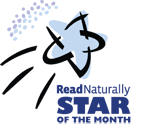After working with a boy named Mathias for a couple of weeks, Read Naturally founder Candyce Ihnot had a hunch that she had placed him in the wrong level. How could she be sure? And what could she do to correct her mistake? The answer was to check his initial placement. Then, after Candyce found the appropriate level and goal for Mathias, she came up with a creative solution to ensure his needs were being met.
Read more Back to School! That phrase seems to imply we’re all settling back into something, doesn’t it? But as all educators know, there’s nothing settled about this time of year. It’s a frenzied, fast-paced new start. We’re all ready to go and to grow—forward and onward, not backward.
Read more At this point in the school year, most of your Read Naturally students are comfortable with the Read Naturally Strategy and able to work mostly independently. You worked hard to properly train them and to place them in the program, and your hard work is paying off as they’re becoming better readers. However, your involvement at this stage in the process is just as important as it was in the beginning. Now, you must turn your attention to keeping your students challenged.
Read more Do you know a student who needs support in both fluency and phonics? If so, we encourage you to check out Read Naturally’s Phonics series. The Phonics series is a group of levels offered within Read Naturally Live and Read Naturally Encore. Students working in the Phonics levels focus on specific phonics skills while simultaneously building fluency.
Read more Picture a struggling reader in your mind. What age is the student? When many people think about struggling readers, they don’t picture teenagers or adults. And yet many middle-school, high-school, and adult learners struggle with reading. To help them achieve literacy, an effective intervention is crucial. Unfortunately, many reading interventions are geared toward younger students. The educators on the Read Naturally team have been aware of this problem since well before the company began in 1991. From the beginning, we have insisted that our programs feature high-interest, nonfiction content. The primary reason for this is so that a Read Naturally intervention can work for a learner of any age.
Read more About 5 million public school students in the United States today are English Language Learners (ELLs). National Public Radio (NPR) recently conducted a robust research project entitled 5 Million Voices, which set out to discover who these students are and how our public schools are serving them.
Read more Happy New Year! We’re kicking off 2017 with some great news. Read Naturally Encore was selected as a District Administration Reader’s Choice Top Product of 2016. District Administration is a reputable source of information for K12 leaders in nearly every district across the country. Their annual awards program highlights the best products in the industry according to the superintendents and other school leaders who are using them in their districts. Read Naturally Encore was one of 100 Top Products chosen from over 1,500 nominations.
Read more Teachers love Read Naturally Strategy programs, first and foremost, because they are so effective in boosting reading achievement. An added bonus is that students work independently for most of the time. However, Read Naturally Strategy programs are not completely independent. The teacher needs to be present at crucial times in order for the strategy to work.
Read more Do your Read Naturally students conduct their cold timings independently? Teachers have different opinions on whether or not they should. Some teachers believe that, in order to get the most accurate data, a teacher should be present during the cold-timing step. Other teachers believe that students should do this step independently in order to practice self-correcting errors. While both points of view are valid, here is Read Naturally's views on cold timings:
Read more In elementary school, I remember participating in a reading incentive program with a simple premise: The more books I read, the more points I’d receive toward a reward. Because of the reward, my classmates and I were highly motivated to spend our free time reading. What’s not to love about a program like that?
There was just one problem. I could read a long, challenging chapter book slightly above my reading level in the same amount of time it took my classmate to read a dozen quick, easy books below his reading level. Who earned more points? My classmate. What did I learn? Quantity beats quality. Don’t challenge yourself.
The program had a fantastic mission, but there was an unintended consequence for me and many other students. Unfortunately, this kind of thing happens often in schools. The only way to avoid it is for teachers to take the time to scrutinize the practices and programs they put to use in their classrooms. Are we doing things out of habit or because others are doing them? Or are we doing things because they truly promote learning? A good educator is one who observes and adjusts—constantly and relentlessly.
Read more  Share your student’s success story—nominate him or her for our Star of the Month award. Win a Barnes & Noble gift card for the student and a Read Naturally gift certificate for your class!
Share your student’s success story—nominate him or her for our Star of the Month award. Win a Barnes & Noble gift card for the student and a Read Naturally gift certificate for your class!